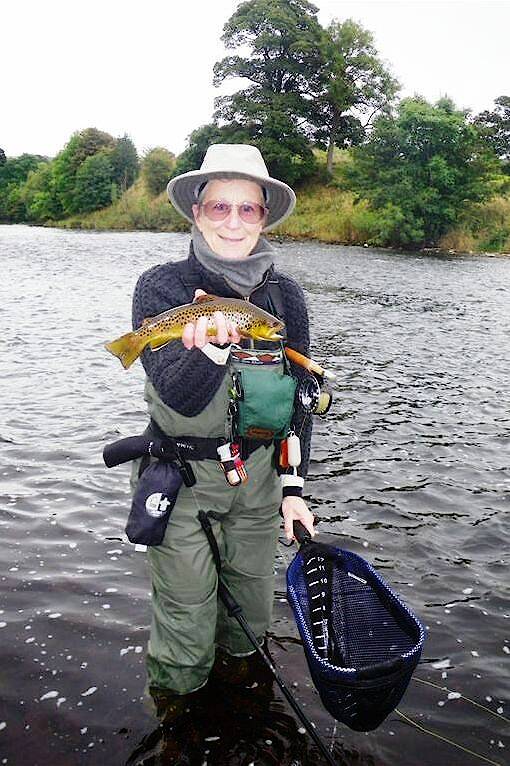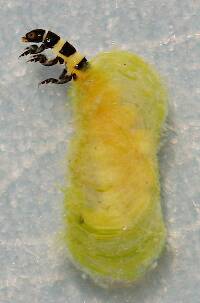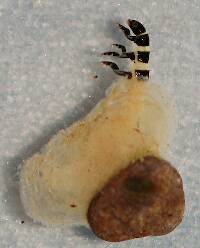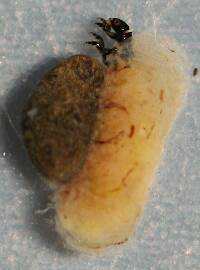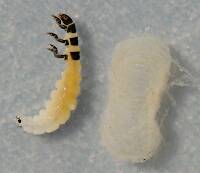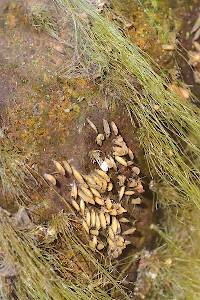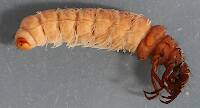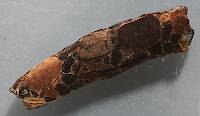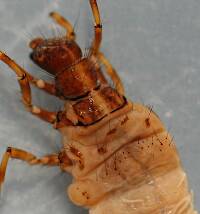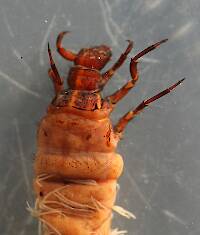
Hex Mayflies
Hexagenia limbata
The famous nocturnal Hex hatch of the Midwest (and a few other lucky locations) stirs to the surface mythically large brown trout that only touch streamers for the rest of the year.
Featured on the forum

This one seems to tentatively key to Holocentropus, although I can't make out the anal spines in Couplet 7 of the Key to Genera of Polycentropodidae Larvae nor the dark bands in Couplet 4 of the Key to Genera of Polycentropodidae Larvae, making me wonder if I went wrong somewhere in keying it out. I don't see where that could have happened, though. It might also be that it's a very immature larva and doesn't possess all the identifying characteristics in the key yet. If Holocentropus is correct, then Holocentropus flavus and Holocentropus interruptus are the two likely possibilities based on range, but I was not able to find a description of their larvae.

Troutnut is a project started in 2003 by salmonid ecologist Jason "Troutnut" Neuswanger to help anglers and
fly tyers unabashedly embrace the entomological side of the sport. Learn more about Troutnut or
support the project for an enhanced experience here.
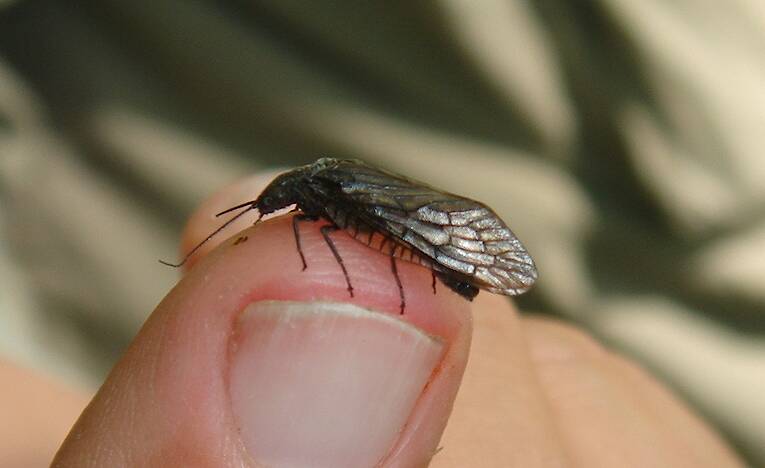

CaseyP on May 28, 2007May 28th, 2007, 1:35 pm EDT
herewith my first attempt to photograph and share a bug.
Best Fishing Buddy welcomed the little guy and asked me if is a caddis. told him i had no idea. maybe it's time for one of those books about bugs on the stream; up to now we've just gone by what the local fly shops tell us to use, so we know the fishing flies better than the real bugs. the pictures on this site under caddis are sort of the same shape.
handheld digital camera with the SAP on--more practice needed, that's for sure! bug hung around quite patiently for a minute and then took off.
Best Fishing Buddy welcomed the little guy and asked me if is a caddis. told him i had no idea. maybe it's time for one of those books about bugs on the stream; up to now we've just gone by what the local fly shops tell us to use, so we know the fishing flies better than the real bugs. the pictures on this site under caddis are sort of the same shape.
handheld digital camera with the SAP on--more practice needed, that's for sure! bug hung around quite patiently for a minute and then took off.
"You can observe a lot by watching." Yogi Berra
Troutnut on May 28, 2007May 28th, 2007, 3:57 pm EDT
Cool bug! That's an alderfly, not a caddisfly. It's a relative of the hellgrammites/dobsonflies/fishflies. It isn't a bug that trout anglers talk about very often. I've got some pictures of the larvae on this site but none of the adults.
Jason Neuswanger, Ph.D.
Troutnut and salmonid ecologist
Troutnut and salmonid ecologist
Martinlf on May 29, 2007May 29th, 2007, 3:08 am EDT
Thanks for the ID, Jason. I believe I saw some of these on the J. How does one distinguish them from Caddis?
Hope the fishing is going well, I'll be looking for a Pocono report soon.
Hope the fishing is going well, I'll be looking for a Pocono report soon.
"He spread them a yard and a half. 'And every one that got away is this big.'"
--Fred Chappell
--Fred Chappell
Quillgordon on May 29, 2007May 29th, 2007, 5:39 am EDT
Louis,
Alderflies have 4 large wings............
Wings are dark brown or gray and heavily veined!
Alderflies have 4 large wings............
Wings are dark brown or gray and heavily veined!
Flyfishing is a state of mind! .............. Q.g.
C/R........barbless
C/R........barbless
Taxon on May 29, 2007May 29th, 2007, 7:12 am EDT
Louis-
Antennae of the alderfly adults are only ½ the body length, as opposed to the caddisfly adults, whose antennae are as long as (or longer than) the body length.
Antennae of the alderfly adults are only ½ the body length, as opposed to the caddisfly adults, whose antennae are as long as (or longer than) the body length.
Troutnut on May 29, 2007May 29th, 2007, 2:03 pm EDT
Look at how the alderfly has a big, wide, flat head and thorax that kind of fit together. Then look at pictures of some caddisflies and you'll see they've all got relatively tiny heads very distinct from the thorax. That seems to be the most obvious difference at a glance, to me.
Also, look on the side view -- you can see all those appendages that run down the side of the larvae. They're still present in the adults.
Also, look on the side view -- you can see all those appendages that run down the side of the larvae. They're still present in the adults.
Jason Neuswanger, Ph.D.
Troutnut and salmonid ecologist
Troutnut and salmonid ecologist
Creno on Dec 21, 2007December 21st, 2007, 3:19 pm EST
Not sure how I arrived at this site as I was looking for a book by Glenn Wiggins. But very interesting. The easiest way to separate adults of caddis from megalops is the hairy (tricho) wings of the caddis and the hairless, shiny (glabrous) wings of the megalops. Great photos so I look forward to spending the rest of the night wandering through them.
Shawnny3 on Dec 21, 2007December 21st, 2007, 11:32 pm EST
Welcome, Creno. I don't know a lot about bugs, but you use enough big words to impress me. Even though you haven't been lurking, you may want to introduce yourself in the "Longtime reader, never-time poster" thread so we can learn a little bit about you.
-Shawn
-Shawn
Jewelry-Quality Artistic Salmon Flies, by Shawn Davis
www.davisflydesigns.com
www.davisflydesigns.com
Creno on Dec 22, 2007December 22nd, 2007, 1:40 pm EST
Shawn - I don't see the forum you suggest so I will reply here. You will see I have spent the afternoon wandering through the rest of the caddis on the site. Amazing stuff! And not just the photos that Troutnut and others put up, but the easy access to all this great information and communication. You folks need to be proud of what you have compiled. Sorry for the big words - I will try to do better.
I used to fish alot (250+ days one year) and now I look at caddis alot (250+ days every year). The majority of my experience has been in the western US but I look at enough eastern material to understand I don't understand it. So I keep plugging away. The photos are really great as most of us bug pickers don't look at any, let alone enough, live material.
If folks looking at this site would like caddis species level determinations for their adult material I would be glad to look at small quantities that are well preserved/documented and do my best. All I ask is that I may keep representative material that I may not have in my collection. In general larval material (and unfortunately too may females) cannot yet be reliably resolved to the species level. It will take the work of both the angling and scientific communities many years yet to work this out.
With best wishes to all for the holidays!
dave - druiter@msn.com
I used to fish alot (250+ days one year) and now I look at caddis alot (250+ days every year). The majority of my experience has been in the western US but I look at enough eastern material to understand I don't understand it. So I keep plugging away. The photos are really great as most of us bug pickers don't look at any, let alone enough, live material.
If folks looking at this site would like caddis species level determinations for their adult material I would be glad to look at small quantities that are well preserved/documented and do my best. All I ask is that I may keep representative material that I may not have in my collection. In general larval material (and unfortunately too may females) cannot yet be reliably resolved to the species level. It will take the work of both the angling and scientific communities many years yet to work this out.
With best wishes to all for the holidays!
dave - druiter@msn.com
Martinlf on Dec 22, 2007December 22nd, 2007, 1:48 pm EST
And best to you Dave.
"He spread them a yard and a half. 'And every one that got away is this big.'"
--Fred Chappell
--Fred Chappell
Quick Reply
Related Discussions
Topic
Replies
Last Reply
1
Mar 31, 2008
by Lifeaquatic
by Lifeaquatic


